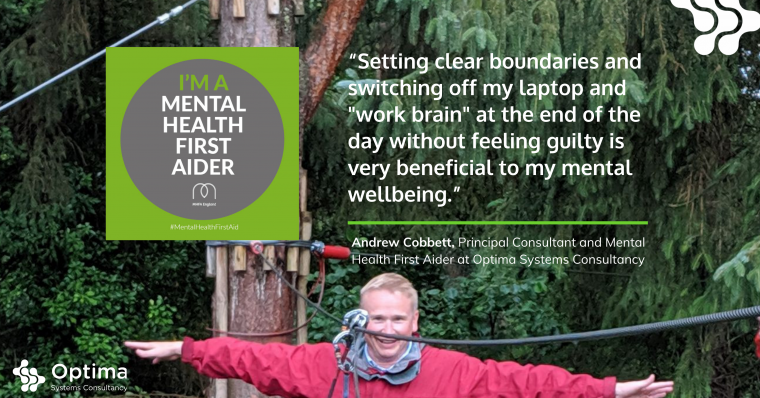Article By Andrew Cobbett, Principal Consultant at Optima Systems Consultancy
The pandemic demanded radical changes for all of us in a very short amount of time. We had no choice but to adapt quickly to a whole new way of life and it has been very challenging.
Many of us are now effectively working three jobs instead of one – as an employee, a parent/caregiver, and a teacher, for example – and the stress of living up to this extraordinary demand can add further grievance to our lives. At this most challenging of times, it is more important than ever to focus on our mental health and wellbeing.
As a Mental Health First Aider (MHFA) for Optima I have been asked about how my MHFA skills have been put into practice during the Coronavirus pandemic and what tips I have for supporting the mental health and wellbeing of my colleagues, friends, family – and importantly myself.
Here’s my top 5 tips for supporting your mental health and wellbeing:
#1. Have a Timetable.
Structure to the day is important when working from home or remotely during the pandemic. It’s very easy to let work and home life become blurred. Having a structure in place, with dedicated down time during the day and fixed start and finish times to the working day (and sticking to them) helps establish the boundaries. I find that, knowing you have finished for the day and switching off your “work brain” without feeling guilty about it is very beneficial to my mental wellbeing.
#2. See Some Daylight.
Talking of down time during the working day, especially during the winter months, it’s important to schedule a longer lunch break, so that you can get outside in the daylight, do some exercise, run a few errands, pop to the shops, whatever you need to do to get a change of scene, feel healthy and perhaps see some other (socially distanced) human beings.
#3. Get Some Exercise.
Incorporating some physical exercise into your routine will give you an enormous mental boost – no matter how sluggish you feel beforehand, doing something active will make you feel much better afterwards. It doesn’t have to be running a marathon before breakfast, it can be a walk round the neighbourhood at lunchtime, 20 minutes of PE with Joe (countless other workouts, Pilates and yoga classes are available on YouTube). Any exercise is better than none at all.
#4. Keep in Touch.
If you’re lucky enough to be part of a home-working “hub” or team, exploit the opportunity this presents and make an effort to do things together – whether it’s a weekly virtual lunch, a quiz or other activities you can run. Working remotely means that we need to make an extra effort to make time for those ‘water cooler’ chats where you can just talk about anything or everything. I’ve found it mentally refreshing to have had a fortnightly diary appointment for a chat with a colleague unconnected with my daily work where we check in with each other talk about whatever comes to mind.
#5. It’s Never Perfect All of the Time.
No matter our personal circumstances, we will always have good days and bad days and we need to acknowledge that. Sometimes the bad days are fleeting blips, but other times we get stuck in a rut. Last Summer I found myself in a rut when I returned from a two-week holiday, being stuck again in the same square metre of my spare bedroom staring at the same screens I had been for the previous 4 months. My family and I had lost our routine, the boundaries between home and work were blurred. I was doing longer days without a corresponding increase in output and I wasn’t doing any exercise so I felt mentally drained. Awareness of my mental health helped me recognise that I had a problem, and, by following the steps I’ve highlighted above (getting back into a routine, being disciplined about down time, doing physical exercise and maintaining those human interactions) helped me to turn things around and feel a lot better.


